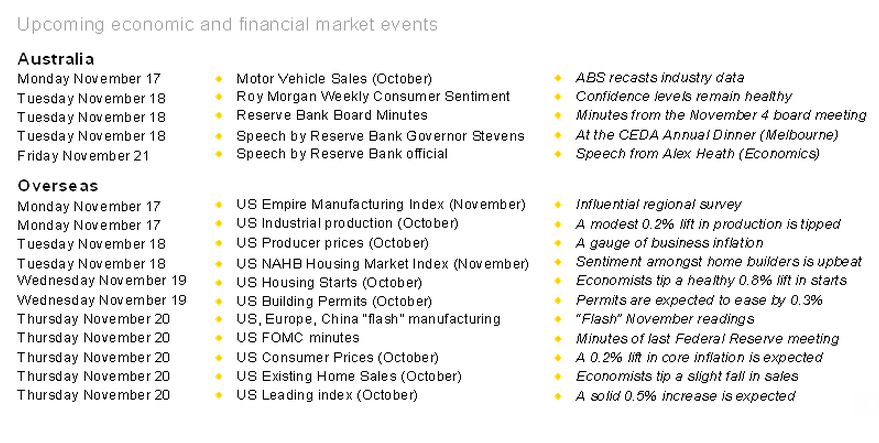The Week Ahead
Reserve Bank dominates domestic calendar
If it wasn't for the Reserve Bank, the coming week would be dull on the domestic economic front. In contrast, in the US, a bevy of top shelf economic releases are expected. And in China, the focus will be on the flash manufacturing gauge, to be released on Thursday.
In Australia, the week kicks off on Monday with the Australian Bureau of Statistics recasting industry data on new car sales in seasonally adjusted and trend terms. The industry data revealed that 91,236 vehicles were sold in October, down 1.5 per cent on a year ago.
On Tuesday Roy Morgan and ANZ release the weekly consumer confidence reading alongside October data on imports of goods. This is one of the timeliest economic indicators, providing insights into business and personal spending.
Also on Tuesday the minutes of the last Reserve Bank board meeting are released. Given that the statement following the no change decision was virtually a carbon copy of the prior month, and the Statement on Monetary Policy was released last Friday, there probably isn't any more to be gleaned on Reserve Bank thinking. But investors and analysts will still pore over the Board minutes in an attempt to uncover new insights.
On Tuesday evening the Reserve Bank Governor Glenn Stevens delivers a speech at the Committee for Economic Development of Australia Annual Dinner in Melbourne.
On Friday the ABS issues the annual State Accounts for 2013/14, detailing “official” economic growth figures for states and territories over the financial year.
Also on Friday the Reserve Bank Head of Economic Analysis Alex Heath delivers a speech at the NSW Mining Industry and Suppliers Conference in Sydney.
Overseas: US data & global flash manufacturing in focus
In the US, the week begins on Monday with data on industrial production and the influential Empire State manufacturing survey. Both indicators should show an ongoing improvement with industrial production expected to lift by 0.2 per cent in October after the 1 per cent lift in September.
On Tuesday capital flows data, the National Association of Home Builders index and the main measure of business inflation (the producer price index (PPI)) are released. A modest lift in the builders' activity index is expected. Economists expect that the PPI fell by 0.1 per cent in October with annual inflation of just 1.2 per cent. If volatile items like food and energy are excluded, prices are likely to have risen by just 0.1 per cent in October.
On Wednesday, the focus will shift to the US Federal Reserve with the release of the minutes of the last FOMC meeting. Investors and analysts will be looking to gain any insights into the timing of future interest rate hikes.
Also the housing sector will be of focus with housing starts and building permits released. Starts are expected to have lifted by 0.8 per cent in October after a sizeable 6.3 per cent increase in September. Similarly a 0.9 per cent lift in building permits is tipped.
On Thursday no fewer than five indicators are expected. The indicators include existing home sales, consumer prices, the influential Philadelphia Federal Reserve survey, the leading index and flash manufacturing gauge. The usual data on claims for unemployment insurance is also issued.
The core reading of consumer prices (excludes food and energy) is tipped to lift just 0.2 per cent in October to be up 1.8 per cent over the year, giving the Federal Reserve ample time before needing to lift interest rates. Existing home sales are expected to have fallen by 0.3 per cent in October to a 5.15 million annual rate. And the leading index is believed to have recorded a solid 0.5 per cent lift in October.
Also on Thursday, the Markit organisation will release mid-month or 'flash' manufacturing indexes for China, European countries and the US.
Global share markets
Rewind seven years to late October/early November 2007 and sharemarkets across the globe were at or near record highs. Then came the global financial crisis, the European debt crisis and hesitant economic recoveries across the globe. Predictably sharemarkets spectacularly slumped in response to the GFC. On March 9 2009, the US Dow Jones was at 6,547, down 54 per cent from the October 9 2007 high of 14,164.
But just as spectacularly as it slumped, the Dow Jones spectacularly recovered, lifting to fresh record highs and up 170 per cent in the past 5½ years since hitting the March 2009 lows.
Similarly European markets have hit fresh record highs this year with the German Dax lifting by 160 per cent since its 2009 lows, while the UK FTSE has lifted by 90 per cent since its 2009 lows.
And while the gains have also been spectacular across Asia, markets have more work to do to return to levels of late 2007. The Japanese Nikkei remains around 8 per cent shy of the peaks in 2007 while the Australian market remains 20 per cent away from the 2007 record highs, having risen too far in the China boom. But importantly, given the significance of dividends, total returns on the Australian market are just below record highs, having risen by 120 per cent since its 2009 lows.














